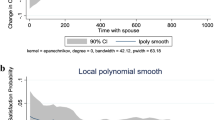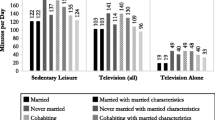Abstract
Using the American Time Use Survey, this chapter explores how mothers and fathers experience specific daily activities utilizing four aspects of subjective well-being. ATUS survey respondents were asked to report how they felt in terms of happiness, meaningfulness, stress, and tiredness while they were engaged in three randomly selected activities they reported from the previous day. We use a simple regression approach and find that mothers are more tired than fathers in each of our aggregated time use activities and report higher stress levels when engaged in paid work, nonpaid work, child caregiving, and leisure activities. However, mothers report greater happiness than fathers when engaged in paid work and leisure. Single nonemployed mothers are particularly unhappy, stressed, and tired, even after controlling for many other characteristics, including education level and household income. Fathers’ subjective well-being also varies by his marital status; single fathers are less happy and attribute less meaning to nonpaid work than married men, and are more stressed while watching TV, but less tired in other forms of leisure than married fathers.
Access this chapter
Tax calculation will be finalised at checkout
Purchases are for personal use only
Similar content being viewed by others
Notes
- 1.
While our findings may be suggestive of time pressure in some circumstances, our data contain no direct answers to questions about time pressure.
- 2.
The hypotheses of interrupted sleep or mothers naturally requiring more sleep have been explored by other researchers, but are not explored here. However, we do include the total number of activities engaged in each day to control for the hypothesized activity overload of mothers and total hours of sleep on diary day.
- 3.
- 4.
In 2012 and 2013, a global life satisfaction question was also included as well as some day specific health information to help put that day’s emotions is context.
- 5.
Defined as having an own child under the age of 18 living in the household.
- 6.
While we control for nonemployment and marital status among fathers via dummy variables, we do not have sufficient samples sizes to interact employment status and marital status for fathers.
- 7.
For a thorough description of the ATUS see Hamermesh et al. (2005).
- 8.
Kalenkoski and Oumtrakool (2015) and Gimenez-Nadal and Sevilla (2016) use the global life satisfaction measure as a control variable in their regression specification in an attempt to calibrate the individual SWB level responses; this necessitates limiting their analysis to the years 2012 and 2013. Hamermesh (this volume) reports the results of a comparison of married and not married mothers using the ATUS from 2012 and 2013 with the global satisfaction variable as the dependent variable.
- 9.
These percentages are calculated using respondent level weights supplied by the BLS in order to reflect the full population of the United States in 2010, 2012, and 2013.
- 10.
We also repeated our basic analysis using ordered probits and the results were essentially unchanged.
- 11.
Results from the more limited specifications are available from the authors upon request. The results were largely robust to the increasing specificity of characteristics included.
- 12.
One might be tempted to include a respondent’s response to the global satisfaction question as a right-hand side variable in order to calibrate responses, but this question was not asked in 2010. We did estimate each of our models with global satisfaction included for the 2 years as a robustness check, and the results were quite similar. In this chapter, we report the results without controlling for global satisfaction, choosing sample size over calibration, given the large number of other variables we include in the model.
- 13.
Both the mean and the standard deviation account for the sampling errors. Stata commands svy:mean followed by estat sd were used.
- 14.
- 15.
We include total time spent sleeping on diary day even though we do not analyze SWB while sleeping. Many of the other papers in this literature have explored the hypothesis that women’s higher reported tiredness and reduced happiness may be the result of them getting less sleep or more interrupted sleep. We do not include a measure of interrupted sleep.
References
Bertrand, M. (2013). Career, family, and the well-being of college-educated women. American Economic Review, 103(3), 244–250.
Connelly, R., & Kimmel, J. (2014). Gender differences in unpaid time use by family structure. In E. Redmont (Ed.), Family economics: How households impact markets and economic growth (Vol. 2, pp. 67–114). ABC-CLIO.
Connelly, R., & Kimmel, J. (2015). If you’re happy and you know it: How do mothers and fathers in the U.S. really feel about caring for their children. Feminist Economics, 21(1), 1–34.
Csitszentmihalyi, M. (1990). Flow: The psychology of optimal experience (320 pp.). Harper and Row.
Deaton, A., & Stone, A. A. (2014). Evaluative and hedonic wellbeing among those with and without children at home. Proceedings of the National Academy of Sciences, 111(4), 1328–1333.
Ferrer-i-Carbonell, A., & Frijters, P. (2004). How important is methodology for the estimates of the determinants of happiness? The Economic Journal, 114(497), 641–659.
Flood, S., Meier, A., & Musick, K. (2020). Reassessing parents’ leisure quality with direct measures of well-being: Do children detract from parents’ down time? Journal of Marriage and Family, 82(4), 1326–1339.
Gershuny, J., & Halpin, B. (1996). Time use, quality of life and process benefits. In A. Offer (Ed.), Pursuit of the quality of life (pp. 188–210). Clarendon Press.
Gimenez-Nadal, J. Ignacio, & Almudena Sevilla. (2016). “Intensive mothering and well-being: The role of education and child care activity,” IZA Discussion Papers No. 10023.
Giménez-Nadal, José Ignacio, José Alberto Molina, & Jorge Velilla. (2020). “Should we cheer together? Gender differences in instantaneous well-being during joint and solo activities: An application to COVID-19 lockdowns,” IZA Discussion Paper No. 13306.
Grossbard, S., & Mukhopadhyay, S. (2013). Children, spousal love, and happiness: An economic analysis. Review of Economics of the Household, 11(3), 447–467.
Hamermesh, D. (this volume). Chapter 10: Mom’s time: Married or not. In: J. A. Molina (Ed.), Mothers in the labor market. Springer.
Hamermesh, D., Frazis, H., & Stewart, J. (2005). Data watch: The American time use survey. Journal of Economic Perspectives, 19(1), 221–232.
Juster, F. T., & Stafford, F. P. (Eds.). (1985). Time, goods, and well-being (542 pp.). Institute for Social Research, University of Michigan.
Kahneman, D., & Krueger, A. B. (2006). Developments in the measurement of subjective well-being. Journal of Economic Perspectives, 20(1), 3–24.
Kahneman, D., Krueger, A. B., Schkade, D. A., Schwarz, N., & Stone, A. A. (2004). A survey method for characterizing daily life experience: The day reconstruction method. Science, 306(5702), 1776–1780.
Kalenkoski, Charlene & Eakamon Oumtrakook. (2015). “The caregiving responsibilities of retirees: What are they and how do they affect retirees’ well-being?” IZA WP 9568.
Kalil, A., Mayer, S., Delgado, W., & Gennetian, L. (2020). The education gradient in maternal enjoyment of time in childcare (Working Paper No. 2020-131 (September), 50pp.). University of Chicago, Becker Friedman Institute for Economics.
Kimmel, J., & Connelly, R. (2007). Mothers’ time choices: Caregiving, leisure, home production and paid work. The Journal of Human Resources, XLII(3), 643–681.
Knabe, A., Ratzel, S., Schob, R., & Weimann, J. (2010). Dissatisfied with life, but having a good day: Time-use and well-being of the unemployed. The Economic Journal, 120(547), 867–889.
Kristoffersen, I. (2017). The metrics of subjective wellbeing data: An empirical evaluation of the ordinal and cardinal comparability of life satisfaction scores. Social Indicators Research, 130, 845–865.
Krueger, A., Kahneman, D., Schkade, D., Schwarz, N., & Stone, A. (2009). National time accounting: The currency of life. In Measuring the subjective well-being of nations: National accounts of time use and well-being (pp. 9–86). University of Chicago Press.
McDonnell, C., Luke, N., & Short, S. E. (2019). Happy moms, happier dads: Gendered caregiving and parents’ affect. Journal of Family Issues, 40(17), 2553–2581.
Meier, A., Musick, K., Flood, S., & Dunifon, R. (2016). Mothering experiences: How single parenthood and employment structure the emotional valence of parenting. Demography, 53, 649–674.
Musick, K., Meier, A., & Flood, S. (2016). How parents fare: Mothers’ and fathers’ subjective well-being in time with children. American Sociological Review, 81, 1069–1095.
Negraia, D. V., & Augustine, J. M. (2019). SES and the emotional “benefits” and “costs” of parenting. Max Planck Institute for Demographic Research.
Negraia, D. V., & Augustine, J. M. (2020). Unpacking the parenting well-being gap: The role of dynamic features of daily life across broader social contexts. Social Psychology Quarterly, 83(3), 207–228.
Nomaguchi, K., & Milkie, M. (2003). Costs and rewards of children: The effects of becoming a parent on adults’ lives. Journal of Marriage and Family, 65(2), 356–374.
Robinson, J., & Godbey, G. (1999). Time for life: The surprising ways Americans use their time (2nd ed., (with Forward by Robert D. Putnam), 424 pp.). Pennsylvania State University Press.
Stone, A., & Shiffman, S. (1994). Ecological momentary assessment (EMA) in behavioral medicine. Annals of Behavioral Medicine, 16, 199–202.
Zelizer, V. A. (1994). Pricing the priceless child: The changing social value of children (295 pp.). Princeton University Press.
Author information
Authors and Affiliations
Corresponding author
Editor information
Editors and Affiliations
Rights and permissions
Copyright information
© 2022 The Author(s), under exclusive license to Springer Nature Switzerland AG
About this chapter
Cite this chapter
Connelly, R., Kimmel, J. (2022). How Do U.S. Moms and Dads Feel About Work and Family?. In: Molina, J.A. (eds) Mothers in the Labor Market. Springer, Cham. https://doi.org/10.1007/978-3-030-99780-9_2
Download citation
DOI: https://doi.org/10.1007/978-3-030-99780-9_2
Published:
Publisher Name: Springer, Cham
Print ISBN: 978-3-030-99779-3
Online ISBN: 978-3-030-99780-9
eBook Packages: Social SciencesSocial Sciences (R0)




